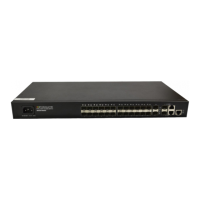QoS Configuration
queue. WRR can configure a weighted value (that is, w3, w2, w1, w0 in turn) which means the
percentage of obtaining the resources. For example: There is a port of 100M. Configure its
WRR queue scheduler value to be 50, 30, 10, 10 (corresponding w3, w2, w1, w0 in turn) to
guarantee the inferior priority queue to gain at least 10Mbit/s bandwidth, to avoid the shortage
of PQ queue scheduler in which packets may not gain the service.
WRR possesses another advantage. The scheduler of many queues is in turn, but the time
for service is not fixed -—if some queue is free, it will change to the next queue scheduler to
make full use of bandwidth resources.
(3) SP+ WRR
Superior priority or less priority use SP algorithm, others use WRR algorithm.
20.1.12 Cos-map Relationship of Hardware Priority
Queue and Priority of IEEE802.1p Protocol
System will map between 802.1p protocol priority of packet and hardware queue priority.
For each packet, system will map it to specified hardware queue priority according to 802.1p
protocol priority of packet.
20.1.13 Slow Mirror
Flow mirror means coping specified data packet to monitor interface to detect network and
exclude failure.
20.1.14 Statistics Based on Flow
Statistics based on flow can statistic and analyze the packets customer interested in.
20.1.15 Copy Packet to CPU
User can copy specified packet to CPU according to the need of its QoS strategies.
System realizes QoS function according to accessing control list, which includes: flow
monitor, interface speed limit, packet redirection, priority mark, queue scheduler, flow mirror,
flow statistics, and coping packet to CPU.
20.2 QOS Configuration
20.2.1 Configuring Flow Monitor
Flow monitor is restriction to flow rate which can monitor the speed of a flow entering
switch. If the flow is beyond specified specification, it will take actions, such as dropping

